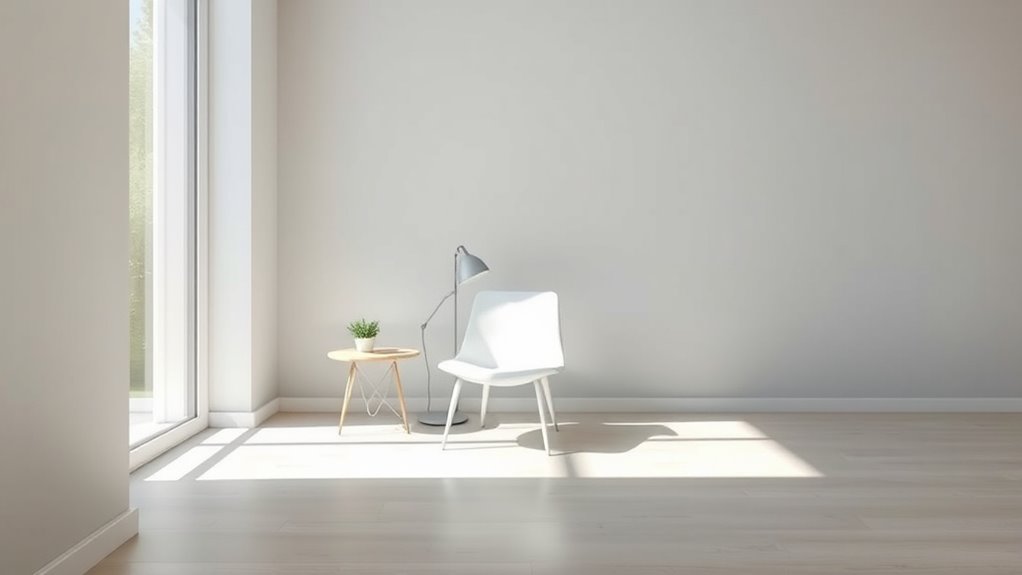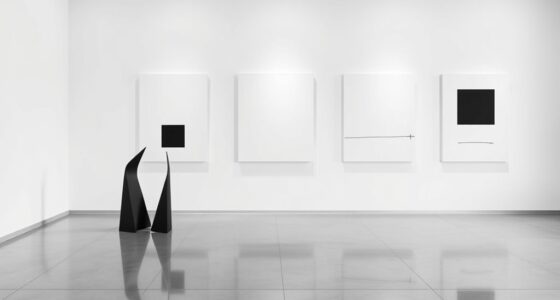Minimalist design helps clear mental clutter, boost focus, and reduce stress by emphasizing simplicity and order. By minimizing visual noise and unnecessary elements, your brain can process information faster, leading to better decision-making and emotional calm. Soothing colors and clean lines create spaces that feel balanced, safe, and inviting, supporting your mental well-being. Keep exploring how these design choices influence your mind, and you’ll discover ways to cultivate a more focused and peaceful environment.
Key Takeaways
- Minimalist design reduces sensory overload, enhancing mental clarity and focus.
- Clear, uncluttered spaces promote feelings of control, decreasing stress and anxiety.
- Simple aesthetics support emotional resilience by fostering calmness and tranquility.
- Fewer visual stimuli improve cognitive processing, boosting creativity and decision-making.
- Thoughtful minimalism encourages mindfulness and well-being through balanced, soothing environments.
The Impact of Simplicity on Mental Clarity
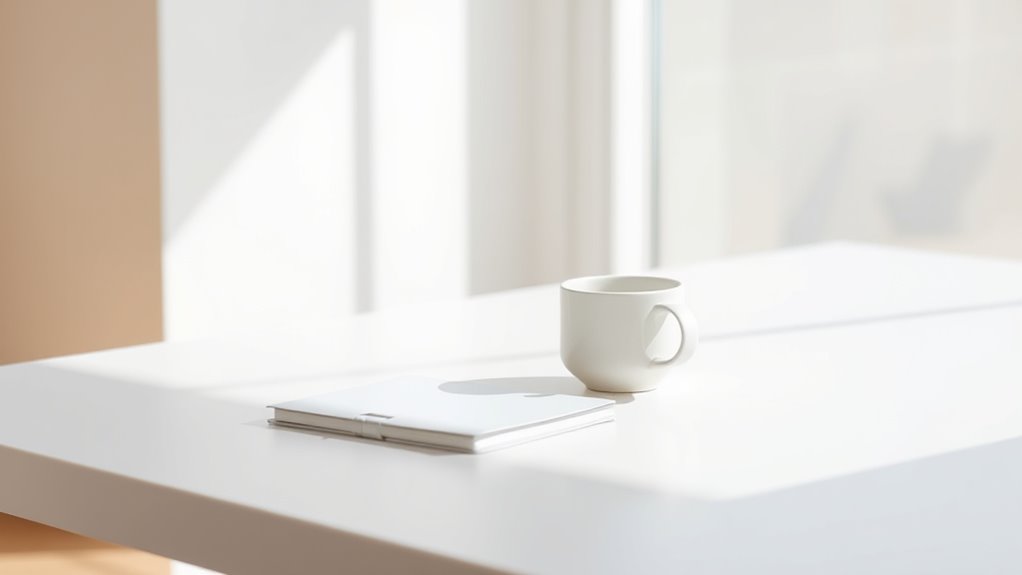
When your environment is cluttered, your mind often feels overwhelmed and distracted. Minimalist design promotes simplicity, which directly impacts your neural pathways by reducing sensory input. This clarity helps streamline thought processes and sharpens mental focus. Incorporating space optimization strategies in your environment can further enhance mental clarity by ensuring that every element serves a purpose. As you declutter, your brain forms fewer associations with unnecessary stimuli, strengthening your neural pathways for essential tasks. This process also boosts emotional resilience, making it easier to manage stress and stay calm under pressure. When your surroundings are simple and organized, your mind isn’t bogged down by chaos. Instead, it can allocate resources to critical thinking and problem-solving. Implementing furniture arrangement techniques can maximize the positive effects of minimalism on mental clarity, creating a more harmonious environment. Additionally, utilizing contrast ratio principles in your visual environment can help reduce eye strain and create a more soothing space for mental relaxation. Being mindful of sensory overload can further support mental well-being by limiting unnecessary stimuli and fostering calmness. Recognizing the importance of visual simplicity can also help prevent cognitive fatigue, allowing your mind to maintain focus over longer periods.
How Minimalism Reduces Cognitive Overload

Minimalist design clears your visual field, making it easier to process information without feeling overwhelmed. By focusing on fewer elements, your mind can concentrate more clearly on what matters most. This simplicity reduces triggers that cause distraction, helping you stay attentive and calm. Additionally, using self-watering plant pots can contribute to a clutter-free environment by minimizing the need for frequent plant care, further supporting mental clarity. Recognizing how attention plays a vital role in creative practice highlights the importance of cultivating a focused environment to enhance cognitive efficiency. Furthermore, embracing urban living with minimalist principles can lead to a more organized and peaceful space that fosters mental well-being. Incorporating necessary cookies ensures seamless navigation and core functionalities, which can reduce frustration and improve overall user experience. Understanding how relationships influence our mental state underscores the value of intentional design in creating calming spaces that promote emotional balance.
Simplifies Visual Field
By reducing unnecessary elements, minimalist design streamlines your visual environment, making it easier for your brain to process information. This simplification enhances your visual perception by removing clutter, allowing your mind to focus on what truly matters. Store hours vary by location, but understanding typical operational times can help you plan your visits more effectively. The aesthetic simplicity guides your eye effortlessly, minimizing distractions and creating a sense of calm. Imagine a clean workspace with only essential tools, a website with ample white space, or a living room with sparse decor. These elements work together to reduce cognitive load and foster clarity. With fewer visual stimuli, your brain can interpret information faster and more accurately. Additionally, minimalist furniture design fosters a sense of order that further reduces mental clutter. Research shows that visual clutter can significantly impair decision-making and task performance, emphasizing how minimalism supports mental clarity. Recognizing the importance of emotional support can also help in creating a calming environment that promotes well-being. Incorporating sound therapy principles, like calming sounds or frequencies, can further enhance mental relaxation within minimalist spaces. Ultimately, minimalism helps you perceive your surroundings more clearly, making the entire visual field easier to understand and navigate.
Enhances Focus Clarity
Reducing visual clutter allows your brain to allocate its resources more effectively, preventing unnecessary mental effort. When your environment is minimalist, you create space for mindfulness practices that enhance your focus. Incorporating calming decor elements can further support a serene mindset, promoting tranquility and mental clarity. Without overwhelming stimuli, your mind naturally enters a state of sensory deprivation, making it easier to concentrate on what truly matters. This clarity helps you process information faster and reduces mental fatigue. Minimalist design minimizes distractions, allowing you to stay present and engaged in tasks. Additionally, cognitive load decreases as distractions are eliminated, and your ability to maintain sustained attention improves. Research shows that visual simplicity can significantly improve mental performance and reduce stress levels. Embracing a minimalist mindset can also foster a more positive emotional state, supporting overall well-being and resilience. Incorporating mindfulness techniques into your environment can further enhance these benefits by cultivating a focused and peaceful outlook.
Reduces Distraction Triggers
When your environment is cluttered with unnecessary objects and visual noise, your brain constantly struggles to filter out distractions, leading to cognitive overload. Visual clutter overwhelms your senses, making it harder to concentrate and process information efficiently. Minimalist design reduces these distraction triggers by simplifying your surroundings. Imagine: – A clean desk with only essential items – A room with neutral tones and open space – Minimal decorative elements drawing focus – Clear visual pathways free of excess clutter. Additionally, interior design principles emphasize spatial arrangement that promotes mental clarity and calmness.
The Role of Color and Space in Emotional Regulation
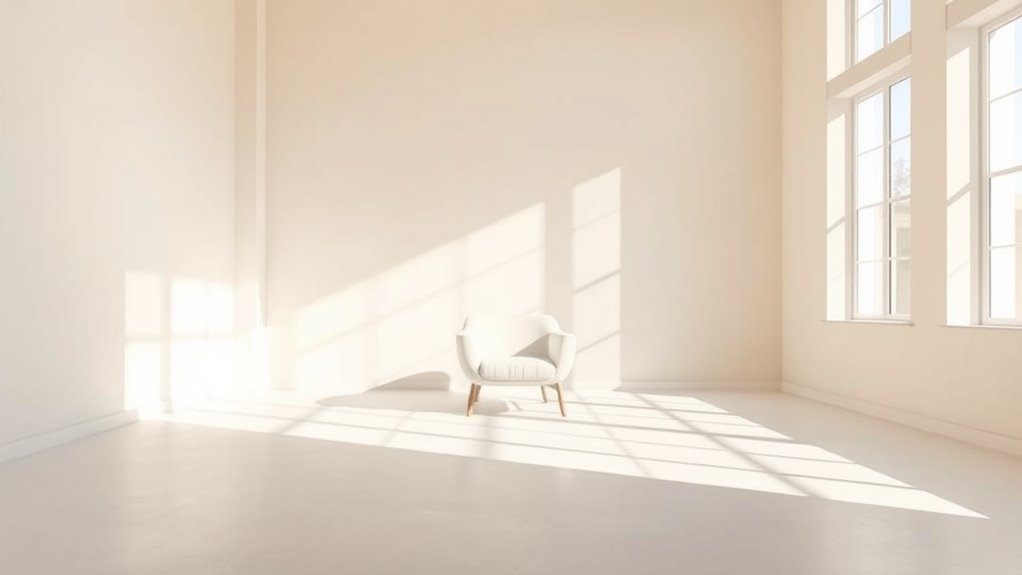
Have you ever noticed how certain colors or open spaces can instantly influence your mood? Color symbolism plays a key role in emotional regulation, as different hues evoke specific feelings—blue promotes calm, while yellow energizes.
In minimalist design, the strategic use of color creates a sense of balance and comfort. Spatial harmony also matters; uncluttered, open spaces reduce feelings of chaos and foster tranquility.
When space is thoughtfully arranged, it allows your mind to breathe, decreasing stress and increasing clarity. Together, color and space in minimalist environments aren’t just aesthetic choices—they’re powerful tools to influence your emotional state.
Minimalist Environments and Stress Reduction
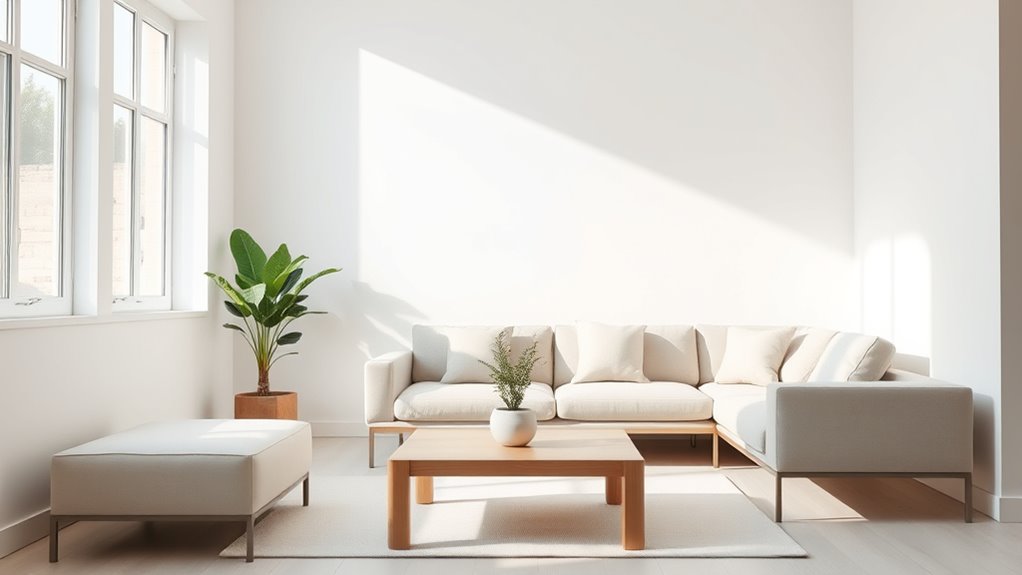
Minimalist environments naturally promote stress reduction by minimizing visual clutter and sensory overload. When your space is simple and organized, your mind feels calmer and more focused. Carefully chosen decorative accents add subtle personality without chaos, creating a sense of harmony.
Material textures, like smooth woods or soft fabrics, invite comfort and warmth, further easing tension. Imagine a room with:
- A sleek, unadorned surface with a single, elegant decorative accent
- Soft, tactile materials like linen or velvet on furniture
- Clean, open spaces with minimal accessories
- Natural light highlighting the subtle textures and accents
These elements work together to foster tranquility. By reducing distractions and emphasizing quality over quantity, minimalist environments help you unwind and lower stress levels naturally.
The Influence of Clean Lines on Focus and Productivity

Clean lines in design create a sense of order that naturally sharpens your focus and boosts productivity. Their simplicity fosters visual harmony, making your workspace feel balanced and uncluttered.
When your environment features clean, straight lines, your mind perceives less chaos, enabling you to concentrate more effectively. The aesthetic appeal of minimalism with crisp edges minimizes distractions, allowing your attention to stay on tasks at hand.
By reducing visual noise, clean lines help you maintain clarity and stay engaged longer. The streamlined look encourages a sense of calm and control, which can enhance your motivation and efficiency.
The Psychological Effect of Clutter-Free Spaces

When your workspace is free of clutter, your mind automatically perceives it as a place of order and control. This clarity reduces stress and enhances focus, making it easier to stay on task.
A clutter-free environment also promotes sensory stimulation that’s calming rather than overwhelming. You might notice a sense of openness that invites creativity through art therapy, encouraging self-expression without distraction.
Visual simplicity helps your brain process information faster, boosting productivity. Imagine:
- Clean surfaces that reflect light, creating a bright, inviting space
- Minimal decorations that foster calm and concentration
- Organized shelves that allow easy access to supplies
- Open spaces that feel expansive and liberating
Such environments support mental clarity, emotional balance, and a sense of well-being, reinforcing the positive psychological effects of minimalism.
Designing for Well-Being: The Mind-Environment Connection
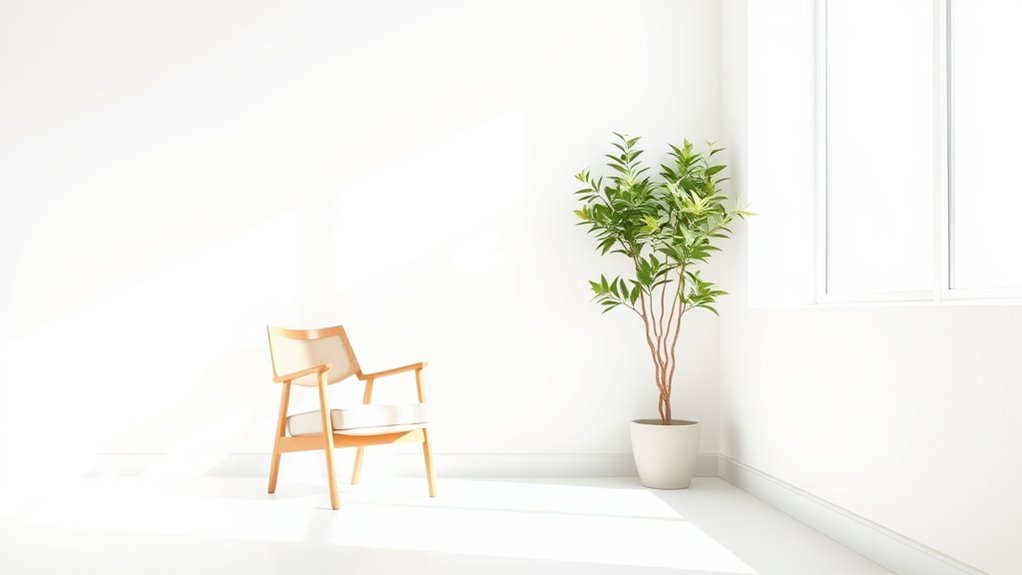
Have you ever considered how your environment directly influences your mental health and overall well-being? Your surroundings shape your space perception, affecting how calm or overwhelmed you feel.
Your environment impacts your mental health and sense of calm or overwhelm.
Minimalist design reduces clutter, allowing your mind to breathe and focus. By controlling sensory stimulation, you create a space that promotes relaxation instead of overstimulation.
Clear, open areas help ease anxiety, while thoughtfully chosen elements support your emotional stability. Less visual noise means your brain isn’t constantly processing unnecessary stimuli, which can improve mood and clarity.
Designing with well-being in mind means intentionally shaping your environment to foster tranquility and balance. When you prioritize simplicity and mindful arrangement, you’re not just creating a beautiful space—you’re nurturing your mental health every day.
Frequently Asked Questions
How Does Minimalism Influence Decision-Making Processes?
Minimalism simplifies your environment, reducing visual clutter and lowering cognitive load, which helps you make decisions more efficiently. When you’re surrounded by fewer distractions, your mind can focus better, leading to clearer choices.
This streamlined approach minimizes overwhelm, enabling you to evaluate options quickly and confidently. In fundamental terms, minimalism guides your decision-making process by creating a calm, organized space that promotes smarter, faster decisions.
Can Minimal Design Improve Mental Health Long-Term?
Imagine a life free from overwhelming chaos—that’s what minimal design can offer for your mental health long-term.
By reducing visual clutter, you gain emotional clarity, making it easier to focus and feel calm.
This simplicity minimizes stress and anxiety, creating a peaceful environment that nurtures your well-being.
Embracing minimalism isn’t just about aesthetics; it’s a powerful tool to improve your mental health every day.
What Psychological Theories Support Minimalist Aesthetics?
You might wonder what psychological theories support minimalist aesthetics. Perceived simplicity reduces cognitive load, making spaces feel less overwhelming and more calming.
The aesthetic appeal of minimalism aligns with the theory that humans prefer clarity and order, which enhances feelings of control and satisfaction.
Gestalt principles also explain how simple, uncluttered designs help your brain process information more easily, fostering focus and reducing stress.
How Does Minimalism Affect Children’s Cognitive Development?
Minimalism minimizes visual clutter, making it easier for children to focus and fostering a longer attention span. When environments are simplified, kids can concentrate better, boosting their cognitive development.
You’ll notice that less distraction helps children process information more effectively, encouraging curiosity and creativity. By creating calm, clutter-free spaces, you support their mental growth and help them develop essential skills for learning and problem-solving.
Are There Cultural Differences in Perceptions of Minimalism?
You might notice that cross-cultural perceptions of minimalism vary considerably, influencing aesthetic preferences worldwide.
In some cultures, minimalism is seen as elegant and sophisticated, while others may view it as cold or lacking warmth. These differences shape how people interpret simplicity and clutter.
Your preferences could reflect your cultural background, affecting whether you see minimalism as calming or stark.
Recognizing these cultural nuances helps you appreciate diverse aesthetic standards and design choices.
Conclusion
By embracing minimalist design, you clear the fog from your mind and open the door to calm and clarity. Think of your space as a quiet lake—still, simple, and reflective of your inner peace. When you strip away the excess, you create a sanctuary where focus blooms and stress dissolves like mist at sunrise. Your environment becomes a mirror of your well-being, guiding you toward a brighter, more centered state of mind.
